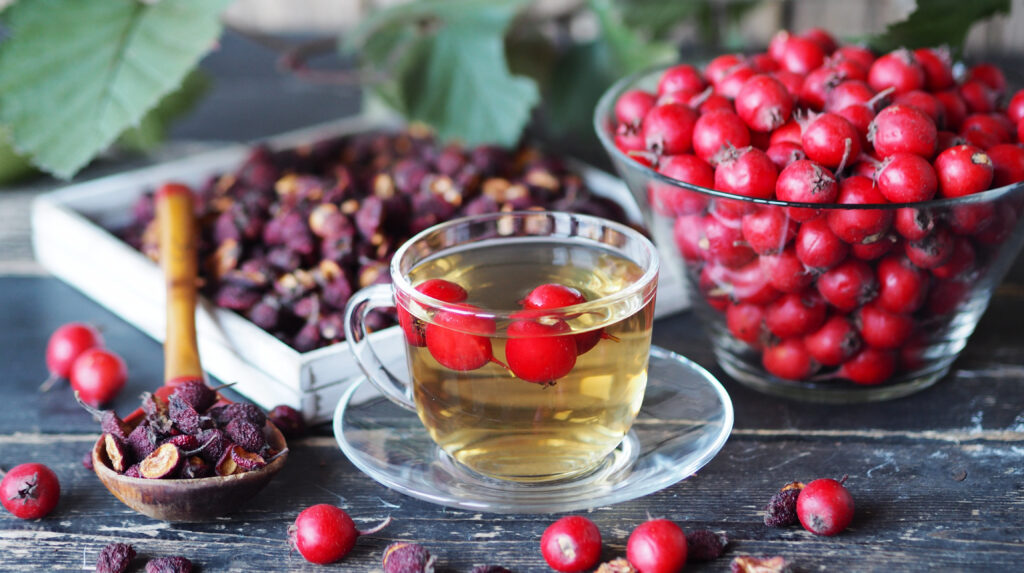By Kathy Abascal
There are many hawthorns on Vashon, and their berries will soon be ready to pick – they are said to make the best medicine after a good frost. Most years, the small trees or shrubs are covered with berries that hang on well through winter. For some reason, few people bother to take advantage of these treasures to dry for tea, to tincture, or process into jam.
The berries are a bit mealy, so perhaps they do not make a superb jam, but I think if hawthorn’s medicinal value were better understood, more people would be planting these pretty trees and gathering their leaves and flowers in the spring and their berries in early winter.
Hawthorn is an old medicine and a tree rich in history. It is also a well-studied medicine. A 2003 analysis in the American Journal of Medicine concluded that hawthorn extracts provide a “significant benefit” as part of treatment plans for chronic heart failure after reviewing eight randomized, double-blind, placebo-controlled studies – the gold standard for medical research. These studies tested patients with stage 2 and stage 3 loss of cardiac output. In stage 2, patients can maintain only a moderate amount of physical activity without negative symptoms. In stage 3, even minor exertion results in shortness of breath.
Hawthorn’s history of heart benefit dates back before the days of Dioscorides, the Greek physician who first documented the plant’s benefits. In the late 1800s, the American Eclectic doctors praised it as a tonic for the heart muscle and counted on it to provide relief from the symptoms of a poorly functioning or tired heart. They thought it gave the heart muscle a bit of rest and, when used regularly, guarded against atherosclerosis. The Germans have long been interested in both heart health and herbal medicine, so it is not surprising that they have led the way in the renewed interest in hawthorn. Dr. Rudolf Fritz Weiss, a famous German herbalist, considered it specific for heart disease.
Hawthorn improves the blood delivery to the heart muscle, which reduces attacks of angina, but it is slow-acting and as such is not used to treat angina attacks. Instead, it improves the delivery of oxygen and other nutrients to the heart muscle over time. When heart function improves, blood pressure tends to go down. While hawthorn is not used to decrease blood pressure as such, when combined with other herbs or antihypertensive prescriptions, it will help to normalize blood pressure. In Germany, it is used as a tonic for hypertensive patients to prevent or treat heart complications that can come with high blood pressure. Hawthorn has also been used to treat mild forms of arrhythmia in elderly patients. Dr. Weiss summarized that hawthorn, “Has rightly been called the drug to care for the ageing heart.”
Hawthorn is called a tonic because it needs to be used regularly over the long term, as it can take many months for full results, especially in the elderly. Fortunately, hawthorn is completely safe and has shown no toxicity in any of many clinical studies. Moreover, many of these studies combined hawthorn with other prescription medications without any negative drug interactions.
The Germans often begin to drink hawthorn tea daily after about age 40. This makes good sense to me. Although the dose will be small, there is every reason to believe the tea will gently but significantly protect the heart from some aspects of aging and poor lifestyle. If the heart issues are more substantial, a higher dose of the tincture will make more sense than just the tea – but no harm in doing both.
Hawthorn grows worldwide, and while there are many species, they all seem to have pretty much the same constituents. I personally use any hawthorn that is growing in a clean, quiet place where it is relaxing and enjoyable to pick the berries. In the spring, I gather the flowers and leaves, which are also strongly medicinal, and mix them with the berries. Those berries will look a bit shriveled after a freeze, but are said to be better that way, and they do make a pleasant-tasting tea.
I highly recommend taking the time to gather some hawthorn berries now that the winter chill has arrived, so you can get in the habit of drinking hawthorn tea as a tonic. It is a good thing to do for your heart.

